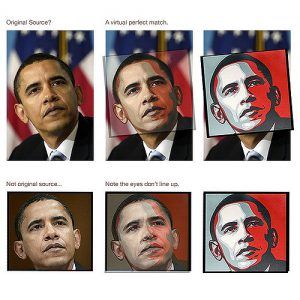
Stevesimula. (2009, January 20). Fairey poster photo source? [Photograph]. Retrieved from https://www.flickr.com/photos/25105505@N07/3212113517/
CSN Libraries works to help students make skillful choices about the ethical use of information. It can be challenging to navigate these issues, which is one reason why “Information Has Value” is considered an information literacy threshold concept (Association of College and Research Libraries, 2016). The “value” given to information is not that just connected to money. Sure, some forms of information, such as patents for medications, can be worth millions of dollars, but what is the monetary value on a Rohingya refugee’s recollection of the destruction of her village? Indeed, information can be used to help or harm. Consider how many people were harmed because tobacco companies withheld information linking smoking with cancer. Finally, as in Fairey’s example, where do we draw the line between being indebted to what inspires us and claiming credit for our new / renewed creations?
This is the second of several posts on threshold concepts and how they relate to the teaching and learning at the heart of CSN Libraries’ mission.
REFERENCES
Artist Shepard Fairey sentenced in Manhattan federal court to 2 years of probation in connection with Obama ‘Hope’ image from 2008 presidential campaign. (2012, Sep 10). US Fed News Service, Including US State News Retrieved from http://ezproxy.library.csn.edu/ login?url=https://search.proquest.com/docview/1038761804?accountid=27953
Association of College and Research Libraries. (2016, January 11). Framework for information literacy for higher education. Retrieved October 5, 2017, from ACRL: Association of College & Research Libraries website: http://www.ala.org/acrl/standards/ilframework
Fairey, S. (2012, September 12). An important message from Shepard Fairey. Retrieved October 23, 2017, from https://obeygiant.com/an-important-message-from-shepard-fairey/


